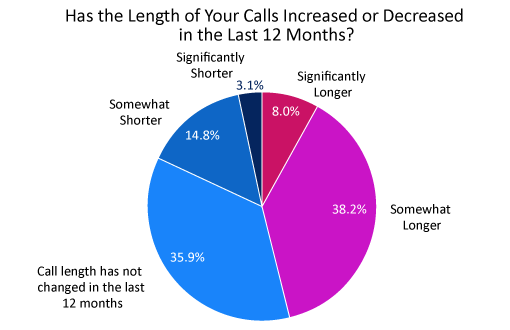According to our 2018 survey “What Contact Centres Are Doing Right Now – How Do You Compare?“, Average Handling Times (AHTs) are increasing.
When we asked more than 350 industry professionals whether their call lengths were increasing or decreasing, the most common response was that handling times were “somewhat increasing”, with 38.1% of participants selecting this option.
As well as this, an additional 7.9% of contact centres said that their calls were significantly longer. This meant that 46.0% of contact centres reported call lengths to have risen, compared to just 17.5% that reported that their call lengths had shortened over the past 12 months.
The remaining 36.5% of contact centres professionals told us that their call lengths remained very similar to those of the previous year.

This poll was sourced from our report: What Contact Centres Are Doing Right Now – How Do You Compare?
Rising call lengths could be reflective of the industry’s rising focus on First Contact Resolution (FCR) or the fact that an increasing number of contact centres are investing more in self-service and virtual assistants to remove transactional call types.
While removing these simple contacts is great for saving resources, contact centres who achieve this goal must pay special attention to their employee engagement. This is because if advisors are taking complex call after complex call, it becomes a much more challenging role.
The simple, transactional interactions are contacts that advisors, to some extent, can use to unwind after tough calls, and these will be the call types that are removed. Contact centres should recognise this if reducing contact volumes is a key goal and think about how they can better support their team.
One idea that contact centres may have to consider is decreasing occupancy when calculating how many advisors are needed in the contact centre, to give advisors more time to recuperate between calls.
It is likely that the contact centre will also have to think of ways to improve their culture to support the team further. Ideas for doing so include starting a knowledge-sharing platform and improving rewards and recognition, as well as arranging contact centre events.
What Else Did Our Survey Tell Us About Average Handling Time?
Another interesting finding from our survey was that AHT is now considered by only 27.3% of contact centre professionals to be an “important metric”, falling by almost 6% in the last year.
These figures could perhaps suggest that fewer contact centres are targeting advisors on the measure, which is great, as doing so may lead to advisors rushing through calls, preventing them from offering their best possible service.
However, those who have listed AHT as an important measure may be referring to the metric’s importance to contact centre WFM processes, such as using an Erlang Calculator to work out how many advisors are needed in the contact centre.
Follow the link to read our 2018 report in full: What Contact Centres Are Doing Right Now – How Do You Compare?
Author: Robyn Coppell
Published On: 5th Dec 2018 - Last modified: 18th Jan 2022
Read more about - Industry News, Business Systems, Diabolocom, Genesys, IFS, Jabra, NICE CXone








































